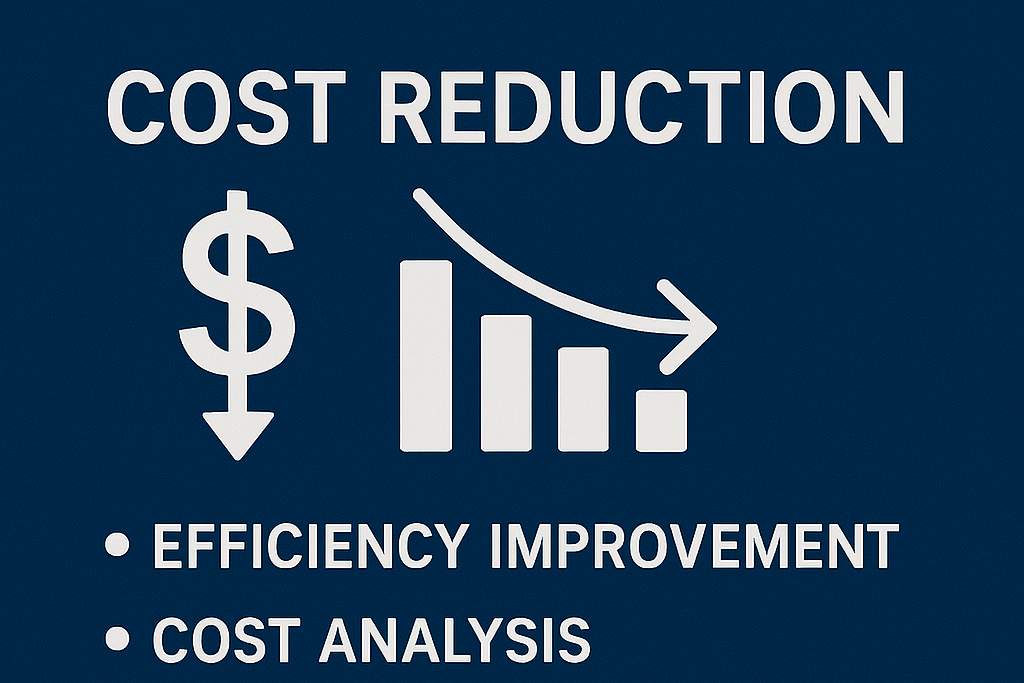In today’s quick-paced and competitive business world, a company’s ability to manage its costs effectivly is key to its survival as well as ongoing success. Although top-line expansion typically comes in the spotlight, a company’s health is equally if not more dependent on its ability to keep expenses tight-fisted and maintain a lean operating structure.
Cost reduction is not cutting corners or imposing bitter cutbacks, but rather a systematic and continuous cycle of waste elimination and identification, improvement of efficiencies, and allocation of resources to those activities that add the greatest value. The pursuit of a leaner bottom line is a continuous process that calls for subtle planning, broad employee involvement, and a readiness to embrace innovation.
Efforts at cost-cutting don’t happen once and are over. The most effective initiatives are comprehensive, addressing spending in all departments, from procurement and operations to marketing and HR. Moreover, best-in-class organizations consider cost management a strategic advantage, not something to be resorted to only in lean economic times. This report will provide an in-depth roadmap for business leaders, outlining a detailed blueprint for cost reduction, fostering a culture of restraint, and ultimately strengthening a firm’s financial foundation so that it can sustain long-term growth.
A data-driven foundation: The all-important starting point of cost analysis
No successful cost-reduction initiative can be implemented until a firm first gains a rich and detailed understanding of its current expenditures. This involves more than a first-level, general review of financial statements and entails a thorough cost breakdown. This is like a diagnosis and involves taking detailed records of all costs, fixed and variable, and questioning each and every line item. By doing this, a business can see just where it is laying out dollars, find unsuspected inefficiencies, and uncover opportunities for expense reduction.
The initial step in this analysis is to group all data by department, activity, and cost driver. That is, are material costs unrealistically high relative to industry standards? Is a huge amount of budget being spent on software subscriptions that are not being properly used? A grasp of these drivers is important because it shifts the conversation from blanket cost-cutting to specific, data-driven action. For example, the proprietor of an eatery can find that the highest food wastage occurs on Tuesdays and Wednesdays. Instead of across-the-board cutting all food purchases, the proprietor can make a menu change or inventory adjustment on those specific days. By benchmarking against the industry average, companies can identify spaces where their costs are divergent with the balance of the competition, providing a clear-cut place for improvement.
Strategic sourcing and vendor management
The vendor-supplier relationship is a highly valuable cost-reduction area that tends to be neglected. Most companies are victim to the trap of complacency and tend to renew contracts and accept the given. By periodically reviewing and renegotiating these contracts, however, companies can save a lot of money.
Leveraging purchasing power by buying in bulk is one of the strongest strategies. Researching group membership bulk suppliers or, with larger companies, the use of group purchasing organizations (GPOs) can unlock better terms that would be out of reach for one company. The second method is to build stronger, longer-term relations with prime suppliers. A stable, consistent buyer supplier is typically more willing to provide good terms, such as payment in advance discounts or more favorable payment terms, which improve cash flow. For critical goods and services, firms should also maintain a diversified portfolio of suppliers. This reduces risk and provides bargaining leverage, as the firm is not dependent on a single supplier. Finally, a “tough but fair” approach of periodically soliciting bids from back-up suppliers unmistakably communicates that the firm is actively managing its costs.
The human element: Conscious labor cost management
Labor cost is often the biggest single expense for most firms, and strict attention to controlling it is critical. While drastic action in the form of firing people can be morale-killing and damaging to employee morale, there are many well-thought-out and strategic alternatives that can reduce costs while either maintaining or even increasing productivity.
One effective strategy is cross-training employees to accomplish multiple tasks and jobs. This creates a more flexible workforce that can cover for vacation time or during peak-demand periods, making temporary staff or overtime unnecessary. Adopting flexible work options, such as remote or hybrid schedules, can also yield substantial returns on overhead expenses incurred from office space, utilities, and repairs. Aside from reducing costs, such policies also enhance employee satisfaction and can lead to cost-saving turnover reduction that spares recruitment and training costs. To cyclical or seasonal firms, giving voluntary unpaid leave or sabbaticals during lean periods can save money without the finality of layoffs. Lastly, promoting employee retention through career development and a good company culture supports lower turnover expenses in the areas of hiring and training new staff.
Operational efficiency and process automation
Inefficient processes are hidden leeches on a company’s resources, squandering time, materials, and money. Striving to remove these process inefficiencies by automating and implementing lean programs can lead to significant, enduring cost reductions.
A close look at every business process is a good starting point. Is waste being created in production, in inventory, or in administrative tasks? Applying lean manufacturing principles, which are aimed at minimizing workflows and eliminating waste, can reengineer the company’s operating model. For companies with intense inventory emphasis, installing a Just-in-Time (JIT) inventory system can prevent overstocking, freeing up cash and reducing storage expenses.
Technology is a wonderful efficiency enabler. Boring and repetitive tasks—such as payroll, invoicing, and data entry—can be automated to dramatically reduce labor hours and the accompanying errors. Spending on good project management and cloud services can even reduce technology costs by bypassing expensive in-house servers and maintenance.
Optimizing sales and marketing costs
Sales and marketing can be the largest expenditure, and without careful consideration, a lot of that money can be wasted. Effective cost savings in this department is not about decreasing marketing spend but applying resources to channels with the highest return on investment (ROI).
Old methods of marketing, such as printed newspaper advertisements, are costly and difficult to track. Online marketing is more quantifiable and often less costly. From data analysis of the performance of the campaign, a company is able to cut back on spending on underperforming channels and transfer the budget to performing channels, such as targeted content marketing, SEO, and social media.
Secondly, retaining an old customer is far cheaper compared to acquiring a new one. Businesses can reduce the cost of marketing by strategically attempting to retain customers over gaining new ones through loyalty schemes, good service, and regular interaction. This also provides a pool of return customers, which is a more stable and predictable source of revenue.
The role of culture and employee engagement
Lastly, the success of any cost-reduction program is company culture and the involvement of its employees. Management can conceive a plan, but frontline staff are normally the first to identify waste and also generate the most creative ideas on how to become more efficient.
To foster this culture, the management must be transparent about the company’s financial goals and the “why” behind cost-saving initiatives. Describing the importance of cost management to the whole team allows them to understand how they can contribute to the company’s success. Allowing department heads budgets and encouraging an ownership mentality can kindle more informed decision-making across the company.
And rewarding and recognizing cost-saving suggestions is an excellent motivator too. Firms can institute award schemes or give incentives to employees who come up with and implement innovative suggestions. Creating channels for employees to provide suggestions and having regular “office hours” to discuss financial matters encourages open communication and financial literacy within the firm.
Conclusion
Means of reducing business expenses are a significant ongoing practice within any firm seeking to thrive in a competitive economy. An effective plan goes beyond across-the-board cuts and involves a thorough strategy built on a data-driven basis, strategic negotiation, intelligent labor management, and commitment to operational effectiveness. By leveraging technology to automate processes, optimizing marketing spend to drive greatest ROI, and most importantly, fostering a culture of employee engagement and ownership, firms can achieve a leaner, more sustainable fiscal model. Lowering costs, strategically and purposefully done, is not an act of austerity but a driver of releasing greater profitability, strengthened cash flow, and propelling lasting, sustainable growth. The journey is ongoing, so ongoing review and fine-tuning, but the reward is a leaner, quicker, and ultimately more effective business.

